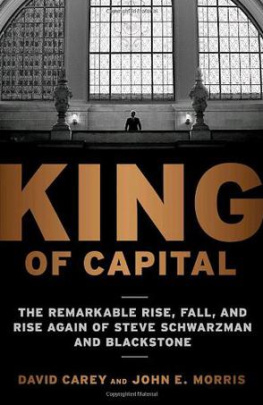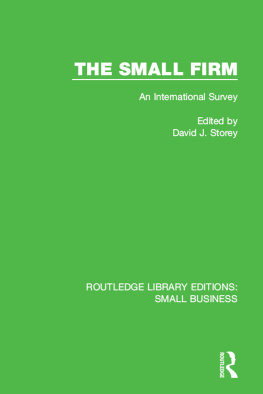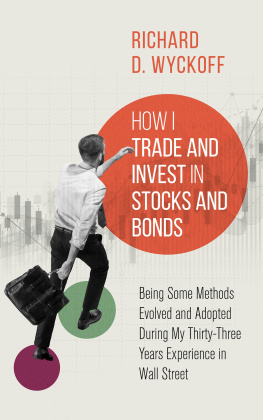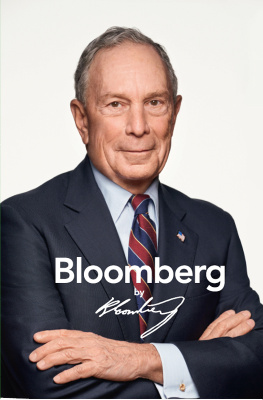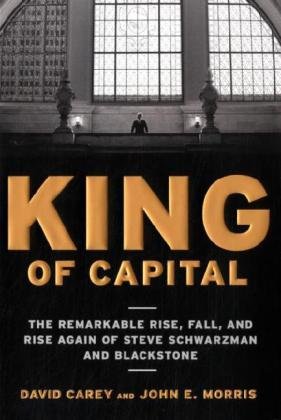Copyright 2010 by David Carey and John E. Morris
All rights reserved.
Published in the United States by Crown Business, an imprint of the Crown Publishing Group, a division of Random House, Inc., New York.
www.crownpublishing.com
CROWN BUSINESS is a trademark and CROWN and the Rising Sun colophon are registered trademarks of Random House, Inc.
Library of Congress Cataloging-in-Publication Data
Carey, David (David Leonard), 1952
King of capital / David Carey and John E. Morris. 1st ed.
p. cm.
1. Blackstone Group. 2. Private equity. 3. Consolidation and merger of corporations. 4. Leveraged buyouts. 5. Financial services industryUnited States. 6. Investment advisorsUnited States. I. Morris, John E., 1957 II. Title.
HG4571.C37 2010
338.83dc22
2010018286
eISBN: 978-0-307-45301-3
v3.1
Dedicated to our parents, Robert B. and Elizabeth S. Morris and Miriam Carey Berry, and to the memory of Leonard A. Carey
CONTENTS
CHAPTER 1
The Debutants
M ore Rumors About His Party Than About His Deals, blared the front-page headline in the New York Times in late January 2007. It was a curtain-raiser for what was shaping up to be the social event of the season, if not the era. By then, the buzz had been building for weeks.
Stephen Schwarzman, cofounder of the Blackstone Group, the worlds largest private equity firm, was about to turn sixty and was planning a fte. The financiers lavish holiday parties were already well known in Manhattans moneyed circles. One year Schwarzman and his wife decorated their twenty-four-room, two-floor spread in Park Avenues toniest apartment building to resemble Schwarzmans favorite spot in St. Tropez, near their summer home on the French Riviera. For his birthday, he decided to top that, taking over the Park Avenue Armory, a fortified brick edifice that occupies a full square block amid the metropoliss most expensive addresses.
On the night of February 13 limousines queued up and the boldface names in tuxedos and evening dresses poured out and filed past an encampment of reporters into the hangarlike armory. TV perennial Barbara Walters was there, Donald and Melania Trump, media diva Tina Brown, Cardinal Egan of the Archdiocese of New York, Sir Howard Stringer, the head of Sony, and a few hundred other luminaries, including the chief executives of some of the nations biggest banks: Jamie Dimon of JPMorgan Chase, Stanley ONeal of Merrill Lynch, Lloyd Blankfein of Goldman Sachs, and Jimmy Cayne of Bear Stearns.
Inside the cavernous armory hung a huge indoor canopy with a darkened sky of sparkling stars suspended above a grand chandelier, mimicking the living room in Schwarzmans $30 million apartment nearby, the New York Post reported the next day. The decor was copied, the paper observed, even down to a grandfather clock and Old Masters paintings on the wall.
R&B star Patti LaBelle was on hand to sing Happy Birthday. Beneath an immense portrait of the financieralso a replica of one hanging in his apartmentthe headliners, singer Rod Stewart and comic Martin Short, strutted and joked into the late hours. Schwarzman had chosen the armory, Short quipped, because it was more intimate than his apartment. Stewart alone was known to charge $1 million for such appearances.
The $3 million gala was a self-coronation for the brash new king of a new Gilded Age, an era when markets were flush and crazy wealth saturated Wall Street and especially the private equity realm, where Schwarzman held sway as the CEO of Blackstone Group.
As soon became clear, the birthday affair was merely a warm-up for a more extravagant coming-out bash: Blackstones initial public offering. By design or by luck, the splash of Schwarzmans party magnified the awe and intrigue when Blackstone revealed its plan to go public five weeks later, on March 22. No other private equity firm of Blackstones size or stature had attempted such a feat, and Blackstones move made official what was already plain to the financial world: Private equitythe business of buying companies with an eye to selling them a few years later at a profithad moved from the outskirts of the economy to its very center. Blackstones clout was so great and its prospects so promising that the Chinese government soon came knocking, asking to buy 10 percent of the company.
When Blackstones shares began trading on June 22 they soared from $31 to $38, as investors clamored to own a piece of the business. At the closing price, the company was worth a stunning $38 billionone-third as much as Goldman Sachs, the undisputed leader among Wall Street investment banks.
Going public had laid bare the fantastic profits that Schwarzmans company was throwing off. So astounding and sensitive were those figures that Blackstone had been reluctant to reveal them even to its own bankers, and it was not until a few weeks before the stock was offered to investors that Blackstone disclosed what its executives made. Blackstone had produced $2.3 billion of profits in 2006 for the firms sixty partnersa staggering $38 million apiece. Schwarzman personally had taken home $398 million that year.
That was just pay. The initial public offering, or IPO, yielded a second windfall for Schwarzman and his partners. Of the $7.1 billion Blackstone raised selling 23.6 percent of the company to public investors and the Chinese government, $4.1 billion went to the Blackstone partners themselves. Schwarzman personally collected $684 million selling a small fraction of his stake. His remaining shares were worth $9.4 billion, ensuring his place among the richest of the rich. Peter Peterson, Blackstones eighty-year-old, semiretired cofounder, garnered $1.9 billion.
The IPO took place amid a financial revolution in which Blackstone and a coterie of competitors were wresting control of corporations around the globe. The private equity, or leveraged buyout, industry was flexing its muscle on a scale not seen since the 1980s. Blackstone, Kohlberg Kravis Roberts and Company, Carlyle Group, Apollo Global Management, Texas Pacific Group, and a half-dozen others, backed by tens of billions of dollars from pension funds, university endowments, and other big investors, had been inching their way up the corporate ladder, taking over $10 billion companies, then $20 billion, $30 billion, and $40 billion companies. By 2007 private equity was behind one of every five mergers worldwide and there seemed to be no limit to its ambition. There was even talk that a buyout firm might swallow Home Depot for $100 billion.
Private equity now permeated the economy. You couldnt purchase a ticket on Orbitz.com, visit a Madame Tussauds wax museum, or drink an Orangina without lining Blackstones pockets. If you bought coffee at Dunkin Donuts or a teddy bear at Toys R Us, slept on a Simmons mattress, skimmed the waves on a Sea-Doo jet ski, turned on a Grohe designer faucet, or purchased razor blades at a Boots pharmacy in London, some other buyout firm was benefiting. Blackstone alone owned all or part of fifty-one companies employing a half-million people and generating $171 billion in sales every year, putting it on a par with the tenth-largest corporation in the world.
The reach of private equity was all the more astonishing for the fact that these firms had tiny staffs and had long operated in the shadows, seldom speaking to the press or revealing details of their investments. Goldman Sachs had 30,500 employees and its profits were published every quarter. Blackstone, despite its vast industrial and real estate holdings, had a mere 1,000 employees and its books were private until it went public. Some of its competitors that controlled multibillion-dollar companies had only the sketchiest of websites.


